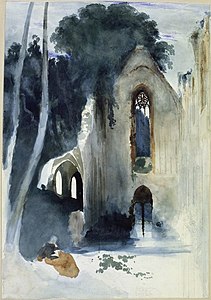Pilgrims resting in a Gothic church ruin

|
| Pilgrims resting in a Gothic church ruin |
|---|
| Karl Blechen , 1833/34 |
| Watercolor on pencil drawing |
| 37.2 x 25.8 cm |
| Kupferstichkabinett Berlin , Berlin |
Pilgrims resting in a Gothic church ruin is an unfinished watercolor by Karl Blechen from 1833/1834. The sheet was one of three preliminary studies for a painting that belonged to the Königsberg art collections and has been missing since 1945. The picture is assigned to Romanticism and is now in the Berlin Kupferstichkabinett .
description
The sheet measures 37.2 × 25.8 cm and is executed as a watercolor over a pencil drawing on vellum paper . It came from Blechen's estate to the Kupferstichkabinett in 1878.
The unfinished work shows a pilgrim on the left in front of a Gothic church ruin, lost in prayer. In the window of the preserved gable remains of the tracery can be seen, which has broken out in the lower area. In addition to the gable, parts of the side walls still exist, the ruin is surrounded by tall trees.
Background and interpretation
The watercolor is a preliminary study for a painting that the Königsberger Kunstverein had ordered from Blechen for the local art collections. In 1834 this painting was shown in the Berlin academy exhibition and was exhibited in the Königsberg Palace until 1945 and has since been considered lost. In addition to this watercolor, there are two other preliminary drawings that the former director of the Berlin National Gallery Paul Ortwin Rave in his 1940 book Karl Blechen. Life, appreciation, work mentioned. It is a drawing in red chalk , sepia and chalk, which had a square pattern for transfer to the canvas (this drawing has also been lost since 1945) and an oil sketch on paper.
The motif of the Gothic ruin appears more often in Blechen's romantic painting. It can be seen as an antithesis and antithesis to Karl Friedrich Schinkel , who endeavored in 19th century Prussia to restore the monasteries, which had fallen into disrepair since the Reformation and secularization , to preserve monuments . Schinkel was striving for a utopian and idealized state of affairs in relation to historical events and people, whereas Blechen illustrated with his works the inexorable decline and decay of all human endeavors into a light-flooded, colorful nature that brings everything back again. The sacred ruin in Blechen's work is a symbol of transience and the romantic longing for the absolute . Not only his light-flooded watercolors from Italy show his admiration for nature, but also this picture, which successfully eliminates the contrast between romantic staging and realistic representation.
Descriptions of spiritual persons, in this picture the devout pilgrim, were characteristic of the art of those decades, they symbolize a spiritual self-discovery. Blechen could have referred to ETA Hoffmann's 1816 novel The Elixirs of the Devil , because he sketched the monk Medardus described there several times in drawings, studies and a painting. Desperate in front of the grave of his doppelganger Viktorin (1834, Georg Schäfer collection ), as an oil study on paper dated 1826, in which Medardus flees with a face contorted with fear (Rave No. 369), in a set-like oil painting with the title Rock Landscape with Monk from 1825, both in the Alte Nationalgalerie , Berlin, and in this picture when Medardus, at the end of his life, sits sunk in melancholy in front of the ruins of his former monastery. But through the cheerfulness of the bright colors and the light (in the watercolor technique, the color-free paper) Blechen indicates a graceful end to his adventurous pilgrimage.
An ink painting on a pen drawing similar to this watercolor was in the collection of the banker Christian Wilhelm Brose , who had acquired a large number of Blechen's works, which were auctioned off by the Kunstantiquariat Hollstein & Puppel in November 1928 after his death in 1870.
literature
- Josef Walch: 2. Karl Blechen: Pilgrims resting in front of the ruins of a Gothic church in the forest, 1834 . In: The art of watercolor . Vista-Point-Verlag, Cologne 1995, OCLC 634732170 .
- Victoria Charles: 543. Karl Blechen 1798–1840, German: pilgrims resting in a Gothic church ruin . In: 1000 watercolors by brilliant masters . Parkstone International, New York 2018, ISBN 978-1-68325-451-5 , pp. 1840 ( books.google.de - reading sample).
Web links
- Pilgrims resting in a Gothic church ruin. smb-digital.de or nat.museum-digital.de (detailed description of the image)
Individual evidence
- ^ Paul Ortwin Rave: Karl Blechen. Life, appreciation, work . German Association for Art History, Berlin 1940, No. 1882 and 1883 .
- ↑ Lothar Brauner in: Carl Blechen. Between romance and realism. Exhibition catalog of the Berlin National Gallery, Prestel-Verlag 1990, ISBN 3-7913-1084-4 , p. 180
- ^ Claude Keisch in: From Caspar David Friedrich to Adolph Menzel. Watercolors and drawings of the Romantic period, from the National Gallery Berlin / GDR (catalog for the exhibition from January 31 to April 21, 1990 in East Berlin and Vienna). Prestel Verlag, Munich 1990, ISBN 3-7913-1047-X , p. 202.
- ^ National Gallery: Carl Blechen - Pater Medardus.
- ^ National Gallery: Carl Blechen - Rocky Landscape with a Monk.
- ^ Peter Krieger in: Paintings of the German Romanticism in the National Gallery Berlin. Frölich & Kaufmann, Berlin 1985, ISBN 3-88725-202-0 , p. 120.
- ^ Marie Ursula Riemann-Reyher in: Das Berliner Kupferstichkabinett. A collection guide. Akademie-Verlag, Berlin 1994, ISBN 3-05-002488-7 , p. 374 ff.
- ↑ C. Brose Collection, Berlin . Hollstein & Puppel, Berlin 1928, p. X ( Textarchiv - Internet Archive - Figure No. 52, text on p. 9).